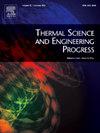A novel type of borehole heat exchanger wrapped with shape-stabilized phase change material
IF 5.1
3区 工程技术
Q2 ENERGY & FUELS
引用次数: 0
Abstract
Phase change materials (PCMs) are often used in borehole heat exchangers (BHEs) to improve their performance. However, the most commonly used method of full borehole backfill still suffers from low efficiency of PCM application and environmental pollution. This study proposes a novel backfill method: wrapping shape-stabilized phase change material (SSPCM) directly around heat exchange tubes to create a novel borehole heat exchanger (NBHE). NBHE improves the application efficiency of SSPCM compared to conventional BHE. In addition, NBHE can completely physically isolate the SSPCM from the soil and avoid PCM leakage. We evaluated the performance of the NBHE using a numerical model validated with experimental data. Based on summer conditions, the performance of the NBHE was compared with that of a BHE with SSPCM in the conventional backfill method. Results showed that, compared to the conventional BHE, the novel backfill method and conventional backfill method improved heat exchange by 33.8 % and 18.3 % on the first day with SSPCM, respectively. After one week of the cycle, the novel backfill method can increase the heat exchange capacity by 113,340 kJ using the conventional backfill method, corresponding to an increase of 11.71 %. In addition, after a one-week cycle, SSPCM recovered consistently in both approaches. Compared with the conventional backfill method, the heat exchange per unit depth of the novel backfill method was enhanced by 26.3 % and 32.2 % when the soil thermal conductivity was 2.48 W/(m·K) and 1.5 W/(m·K), respectively. Furthermore, the heat exchange per unit depth decreases as the initial soil temperature increases.
求助全文
约1分钟内获得全文
求助全文
来源期刊

Thermal Science and Engineering Progress
Chemical Engineering-Fluid Flow and Transfer Processes
CiteScore
7.20
自引率
10.40%
发文量
327
审稿时长
41 days
期刊介绍:
Thermal Science and Engineering Progress (TSEP) publishes original, high-quality research articles that span activities ranging from fundamental scientific research and discussion of the more controversial thermodynamic theories, to developments in thermal engineering that are in many instances examples of the way scientists and engineers are addressing the challenges facing a growing population – smart cities and global warming – maximising thermodynamic efficiencies and minimising all heat losses. It is intended that these will be of current relevance and interest to industry, academia and other practitioners. It is evident that many specialised journals in thermal and, to some extent, in fluid disciplines tend to focus on topics that can be classified as fundamental in nature, or are ‘applied’ and near-market. Thermal Science and Engineering Progress will bridge the gap between these two areas, allowing authors to make an easy choice, should they or a journal editor feel that their papers are ‘out of scope’ when considering other journals. The range of topics covered by Thermal Science and Engineering Progress addresses the rapid rate of development being made in thermal transfer processes as they affect traditional fields, and important growth in the topical research areas of aerospace, thermal biological and medical systems, electronics and nano-technologies, renewable energy systems, food production (including agriculture), and the need to minimise man-made thermal impacts on climate change. Review articles on appropriate topics for TSEP are encouraged, although until TSEP is fully established, these will be limited in number. Before submitting such articles, please contact one of the Editors, or a member of the Editorial Advisory Board with an outline of your proposal and your expertise in the area of your review.
 求助内容:
求助内容: 应助结果提醒方式:
应助结果提醒方式:


